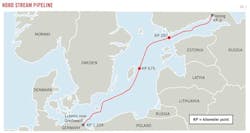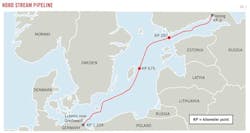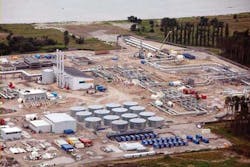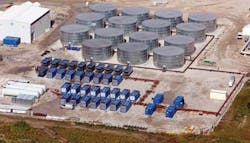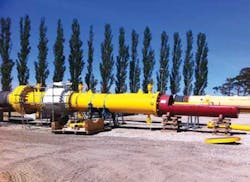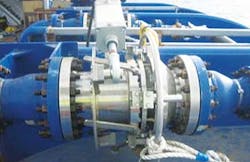Marco Casirati Jarleiv Maribu
Nord Stream AG
Zug, Switzerland
John Grover Daniel Fehnert
Baker Hughes PPS
Dubai
| Based on presentation to Deep Offshore Technology (DOT) International Oil and Gas Conference, Perth, Australia, Nov. 27-29, 2012. |
As subsea natural gas pipelines get longer and more remote, precommissioning requires increased integration into the overall project plan. The 1,224-km (760-mile) twin Nord Stream natural gas pipeline completed precommissioning Line 1 in September 2011, ahead of schedule, and finished Line 2 precommissioning 1 year later. This first part of the article details the planning, engineering, and preparation for Nord Stream's precommissioning, with the second part addressing relevant field experience collected during execution.
Nord Stream was the world's longest-ever single-section dewatering operation, including the longest travel distance for tie-in sealing tools. Establishing a concept, engineering and planning, selecting a main water source and water treatment regime, and identifying risks were among the tasks project managers undertook at the earliest practicable juncture.
Effective dewatering was confirmed by the quick drying operation which followed. An effective water-treatment concept minimized effects on the environment. Favorable temperatures allowed for quick and effective pressure testing.
The entire process was helped by pigs specifically designed for the Nord Stream precommissioning. Successful pig tracking allowed good control and operational confidence.
Background
Nord Stream consists of two 48-in. OD subsea pipelines running 1,224 km from Russia to Germany through the Baltic Sea, the world's longest single-section offshore pipelines. The pipelines export gas from Vyborg, Russia, crossing the Gulf of Finland and the Baltic Sea, to a receiving terminal in Lubmin (near Greifswald), Germany. In addition to crossing Russia and Germany, the pipelines cross the Exclusive Economic Zones (EEZ) of Finland, Sweden, and Denmark (Fig. 1). Each pipeline can ship 84 million standard cu m/day, a combined 55 billion scm/year.
Pipeline design featured a segmented design-pressure concept matching the route's gas pressure profile. Fig. 2 shows the pipelines' configuration. There are no intermediate platforms along the route. Pressure testing each of Nord Stream's three sections separately required installation of offshore subsea terminations (start-up and laydown heads) designed for start-up-abandonment operations and subsequent precommissioning, respectively. Hyperbaric tie-ins subsequently joined the sections at KP 297 and KP 675, creating a single 1,224-km pipeline.
Saipem served as main contractor for pipelay and precommissioning, with Baker Hughes the precommissioning subcontractor. As further described below, the design and construction concept affected precommissioning execution.
Precommissioning concept
The initial precommissioning concept called for water filling via large-diameter crossovers at the subsea tie-in sites. Subsequently installing high-pressure crossovers would allow pressure testing, requiring all three sections of the pipeline to be laid before starting precommissioning.
Since the German area consisted of an almost closed bay with shallow water and low currents, flooding would have taken place from Russia to Germany with dewatering in the opposite direction. This plan required installing a water winning and injection spread at the Russian landfall and an air spread at the German landfall.
The concept called for caustic soda (NaOH) and sodium bisulfite (NaHSO3) to be used as additives to reduce water treatment's environmental impact. Caustic soda would stifle anaerobic bacteria, with bisulfite acting as an oxygen scavenger. Using caustic soda raised concerns because of the possibility of precipitation of carbonates and blockage at crossovers. Detailed water sampling and analysis were planned to address these concerns.
All precommissioning on the Nord Stream project needed to take place as "one-shot" operations that could not be repeated or reversed without major schedule impacts or exceeding permit limitations for water disposal.
Nord Stream, Saipem, and Baker Hughes continued to discuss precommissioning, eventually deciding on an approach based on intervention at the wet end(s) of each pipeline section via subsea construction vessel (SCV). This approach allowed each section to be completed independently of any other sections and Section 1 (closest to Russia) to be precommissioned earlier in the year while the sea at the Russian coast remained frozen and while Section 3 pipelay was still ongoing. This approach significantly increased schedule flexibility. The final precommissioning concept included:
• Precommissioning spreads onshore in autonomous areas separate from construction sites used for permanent facilities.
• Precommissioning pigs for the subsea pipeline not traversing the permanent pig traps or permanent valves.
• Flooding, cleaning, and gauging performed offshore aboard the SCV. All subsea handling was performed by ROV.
• Water treated with sodium bisulfite (NaHSO3) and ultraviolet light (UV) only.
• Pressure test of Sections 1 and 2 from SCV.
• Pressure test of Section 3 from the receiving terminal in Germany (to reduce vessel time and risk from waiting on weather).
• Dewatering the line from Germany with water discharge in Russia, after completing subsea hyperbaric tie-in at KP 297 and KP 675.
• Drying from Germany to Russia.
• Using nitrogen as a barrier between air and gas during commissioning of the pipelines.
The flooding, cleaning, gauging, and pressure-testing spread installed aboard the Saipem vessel Far Samson included suction pumps, a water-treatment system, and flooding and pressure-test pumps. Pressure-test pumps for Section 3 were at the German landfall. Dewatering and drying occurred at German landfall and included 15 steel water tanks, each holding 760-cu m. The water receiving facility at the Russian landfall included a settling pond and a temporary 20-in. diameter floating discharge line.
The flooding, cleaning, and gauging (FCG) pig train design ensured that the operation could be completed in a single pig run while providing contingency pigs to address wet buckle scenarios during pipe laying activities. Bidirectional pigs were back loaded into the subsea test head and installed on the seabed up to 1 year before the operation.
Dewatering pig train design likewise ensured that water removal and desalination could be completed in a single pig run. Slugs of potable water designed to dilute the residual salt content remaining on the pipe wall to an acceptable level separated the first batch of four pigs. Dry air separated the second batch of four pigs, designed to pick up water remaining after the desalination pigs. Spacing of the pig train allowed the first four pigs to be received and removed before arrival of the second set of four pigs.
Constraints
Nord Stream precommissioning included the world's longest offshore dewatering operation and the world's longest sealing tool run. Development of a pig-tracking system helped ensure pig integrity along the full pipeline length and was essential in establishing sites where gauge-plate damage might occur or pigs might get stuck.
Each 48-in. OD pipeline had an internal volume of 1.3-million cu m. The maximum water depth, combined with losses, required a dewatering pressure of 29 barg and a very large air-compressor spread in Germany. The large flooding spread taxed the SCV's deck space, accommodations, ROVs, cranes, and power generators, with the fitting of all necessary equipment in a manner allowing safe operation requiring input from specialists.
Most of the Baltic Sea freezes in winter, limiting the window for offshore operations. Water winning and water disposal could not occur while the sea was frozen.
Water-treatment planning sought to find the most environmentally friendly approach, complying with applicable international and local regulations while maintaining corrosion protection and minimizing the possible formation of precipitates inside the pipeline. Strict noise restrictions required purchasing a custom air-compressor spread to ensure compliance.
The large diesel volumes necessary to fuel the compressor spread in Germany required a custom diesel storage and handling system to receive and distribute 100 cu m/day with no containment loss. A comprehensive waste-management system separated, tracked, and managed all waste produced during project execution.
Execution
Nord Stream awarded the precommissioning contract in August 2009. A 9-month tendering process allowed sufficient time to consider multiple concepts before award. Running this tender concurrently with other project approvals allowed for immediate commencement.
The engineering procedures prepared for precommissioning included 110 documents developed over 18 months, which required review and approval by both Saipem and Nord Stream. The 18-month period was necessary not only to complete the base scope engineering, but also to evaluate all possible options and changes thoroughly.
Meeting flow and pressure demands while achieving the strict environmental and noise targets set required a large percentage of the precommissioning equipment be procured new for the project. Early award of the precommissioning contract afforded 12 months for equipment building, testing, and delivery. Some vendors did not meet their delivery schedules, but the 12-month window allowed sufficient slack for this not to affect the project's schedule.
Flooding, cleaning, gauging and pressure testing (FCGT) took 41 days on Pipeline 1 and 38 days on Pipeline 2. Having contingency plans in place for all of the critical equipment and fully testing the inspection spread ashore allowed for successful FCGT operations.
Dewatering, drying, and nitrogen injection followed FCGT. Full precommissioning of each line took fewer than 150 days, from commencement of FCGT to completion of nitrogen injection.
Compressor, dryer
Precommissioning of the pipelines required two major equipment spreads, the FCGT spread offshore and the compressor spread onshore in Germany. The FCGT spread provided filtered and treated seawater to propel the pig train at 0.5 – 1.0 m/sec, cleaning and gauging the pipeline while filling it with water for the pressure test.
The FCGT spread required 10,000 hp of diesel-driven pumping equipment and 750 kw from the SCV's onboard generators. Spread installation, testing, and certification took 7 days, while the vessel was in port at Norrkoping, Sweden. Spread design used electrically driven submersible pumps 5 to 20 m below the sea surface to feed water through the 2-stage filtration system; primary filtration to 200 µm and final filtration to 50 µm.
Treating the water with UV and then metering and treating with sodium bisulfate followed filtration. Twin 6-in. diameter LFH downlines and 8-in. diameter low-pressure hot stabs boosted pressure through the flooding pumps and injected the water into subsea test heads. All subsea hose handling and connection was performed by work-class Innovator ROV and supported by the vessel crane. The flooding spread consistently achieved flow rates up to 2,500 cu m/hr with no mechanical downtime.
Compressor spread design and installation focused on providing dry, oil-free air to push the pig train for dewatering and to subsequently dry the pipeline, with the spread specifically built for the project. Primary compressors delivered 34 barg of air with 34 barg dryers. The 24,000-hp dewatering spread ensured a minimum free air delivery of 30,000 scf/min injected into the pipeline at ≥ -60° C. dewpoint. The dryers also used active carbon filtration to prevent oil carryover into the pipelines, as required by ISO 8573-1 Class 2.
The compressor spread included central diesel storage of 200 cu m and a distribution system capable of handling 100 cu m/day of diesel. Air spread condensation storage was 100 cu m. Diesel and condensate system design ensured zero losses to the environment and were approved and certified by Technischer Überwachungs-Verein (TÜV).
German landfall also included 18,000 sq m of hard standing, 11,400 cu m of water storage, and more than 1,500 m of steel pipework (Fig. 3-4).
The Russian landfall area served mainly as a receiving terminal for precommissioning water. A 6,000-cu m water storage pond allowed any discolored water from the pipeline to settle and be appropriately disposed.
The 20-in. diameter, 1,200-m water disposal line consisted of 600 m of steel pipe onshore and 600 m of floating HDPE pipe offshore. Water removed during dewatering was piped to its permitted discharge site (at a location with a water depth of more than 5 m) and released back into the sea via a dedicated diffuser system.
Pig traps
Permanent pig launchers, pig receivers, and all permanent valves were not included in the precommissioning scope in an effort to avoid any damage. The temporary pig traps (Fig. 5) designed and built for the project had a 50-barg design pressure, using a 48-in. ball valve, which allowed for the individual launching of the dewatering pigs from Germany.
The four FCG pigs, eight dewatering pigs, and the four sealing tools (inserted in the pipeline by the tie-in operator) arrived in Russia in batches of four pigs.
Each subsea section termination required a subsea head that could either receive or launch the FCG pig train and was designed to be used during the pressure test. Despite their sizes (48-in. diameter x 25 m), these heads also had to pass through the firing line on the pipelay vessel.
Design, construction, and testing of the subsea heads included tight controls and several stages of testing, validation, and retesting to ensure 100% head integrity during deployment, flooding, and pressure test operations.
Hot stabs
ROV hot stabs connected the FCGT downlines to the subsea heads. The three sizes used were:
• 8-in. diameter (low pressure) for flooding.
• 4-in. diameter (high pressure) for pressure testing.
• 1-in. diameter (high pressure) for pressure test instrumentation.
Inserting the 8-in. and 4-in. hot stabs hydraulically into balanced T-design receptacles kept friction loss low and left open the possibility of inserting the stab from either side of the subsea head. Engineers also developed a hydraulic hot-stab extractor tool which could push out a locked stab if necessary.
The project conducted both dry trials and full-scale wet trials in a Norwegian fjord to confirm the hot stabbing operation and hose deployment arrangement.
Hoses, coupling
Baker Hughes proposed using lay-flat hoses based on previous experience working with them on projects in Asia. Such hoses require far less deck space than hard-wall hoses. Flooding used two 6-in. LFH supported by steel downwires and suspended clump weights. During pressurization the LFH expands, creating an internal bore comparable to an 8-in. diameter hard-wall hose.
A system developed for the project enabled the SCV to disconnect quickly and safely from the subsea heads in the event of an emergency such as a dynamic positioning (DP) run away. The DP controller can release all the hoses and downwire from the vessel at the push of a single button. The hoses and downwire remain attached to the subsea heads and suspended from buoys for subsequent reconnection (Fig. 6-7). Activation of the disconnect system would shut down all pumps aboard, while internal check valves ensured water from the pipeline was not released.
Acknowledgment
The authors wish to make special mention of the Nord Stream precommissioning team leads for their contributions to this article: Andrew Turnbull, senior project engineer, and Giuseppe Lopez, senior project engineer.
The authors
Marco Casirati ([email protected]) is project manager for Nord Stream AG in charge of precommissioning, commissioning, gas-in, and shore approach at the Russian landfall, with overall responsibility for the concept, design, and performance of operations. He has held this position since October 2008. He has also served as project director for engineering, procurement, construction, and installation (EPCI) on the Dolphin Sea Lines and Export Pipelines and has managed other projects, such as the Libya Gas Transmission System (GreenStream) and the offshore section of Blue Stream. Casirati holds a PhD in aeronautical engineering from the Polytechnic University of Milan, Italy.
Jarleiv Maribu ([email protected]) is an advisor with Nord Stream AG on engineering, precommissioning, and commissioning matters. Maribu has been in this role since October 2008. He has also served as responsible manager for precommissioning concepts, planning, and execution of all pipeline systems with Statoil, Norway. Maribu holds an MS in mechanical engineering from the Norwegian Technical University, Trondheim.
Daniel Fehnert ([email protected]) is Eastern hemisphere operations manager with Baker Hughes Process & Pipeline Services, based in Dubai. He has 19 years of experience in providing process and pipeline commissioning and precommissioning services around the world and was the Baker Hughes project manager on Nord Stream. Fehnert is a PMI, PMP certified project manager and holds a first-class engineering degree from the University of Newcastle upon Tyne, UK.
John Grover ([email protected]) is with Baker Hughes Process & Pipeline Services as director–Eastern hemisphere, overseeing all pipeline precommissioning operations performed in Europe, Africa, CIS, Russia, Middle East, Far East, and Australia. Grover is based in Dubai and has been in this role since July 2010 and with Baker Hughes since 2005. He has also served as manager at the PII pipeline inspection business of GE Energy. Grover holds a higher national certificate in electronic engineering from Norwich City College.
